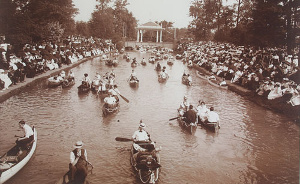talking history | syllabi | students | teachers | puzzle | about us
Detroit Publishing Company: Photographer to the World
http://www.thehenryford.org/exhibits/dpc/default.asp
Created and maintained by Henry Ford Museum.
Reviewed Aug. 2010.
The Henry Ford Museum’s online exhibit Detroit Publishing Company: Photographer to the World provides viewers with over 250 prints, photos, postcards, and documents that depict aspects of the company’s history, operations, and products between 1895 and 1924. It also answers some intriguing questions about photography at the turn of the twentieth century. How did photographers go about their work in an age of large cameras and glass plate negatives? How were black-and-white negatives transformed into color photos? The exhibit also provides insight into the nature of photography, supporting scholarship that suggests that photos are subjective, incomplete witnesses.

"Rowing on the Grand Canal at Belle Isle,
Detroit, Michigan," About 1907.
Created in 2002, the online exhibit is based on a 2000–2001 museum exhibit. It seems geared to the general public, but contains valuable documents for scholars and teachers. The exhibit is organized into nine discrete sections. The first two introduce the company (“DPC History”) and describe the process of creating photos and other products, “How Did They Do It?” The other sections showcase the collection, focusing on “Cityscapes,” "Everyday Life,“ "Foreign Views,” "Getting Around,“ "Michigan Views,” "Nature,“ and ”Work Places."
The goal of the showcase sections appears to be to depict the large scope and scale of the company’s output. Each section has a wide range of diverse and eclectic images from as many places as possible. “Getting Around” features transportation. The images depict a New Hampshire train station; a New York City elevated railroad; wagons on a dirt road to Cripple Creek, Colorado; boys on bikes; ships and boats; a horse-drawn coach; donkey carts; rolling chairs; automobiles; and a pony. The locations span the nation and include cities, ports, small towns, rural areas, and mountains. The other sections are similarly organized.
Navigation of the site is easy and straightforward. Viewers proceed through the sections by clicking on an icon. They can also move back through a section to see prior images. Each picture appears with a brief descriptive caption and viewers can access a larger image.
The sections on company history and the production process create a value-added context. The Detroit Publishing Company history link describes the origins and development of the company, whose most famous photographer was William H. Jackson. It also offers information on the commercial photography industry in the late nineteenth and early twentieth centuries. The section on how they did it shows the photographic equipment that was used, depicts photographers taking pictures, provides photos of the special railroad cars that carried the photographers around the country, and details the processes used to manipulate the photographs for artistic and commercial purposes.
The Detroit Publishing Company: Photographer to the World online exhibit provides a broad panorama of American life at the turn of the twentieth century. The section organization helps viewers select an aspect of life to explore, but the real treasure may be the sections on company history and production that offer insight into commercial photography and the slippery nature of photos.
Mark Newman
National-Louis University
Chicago, Illinois
